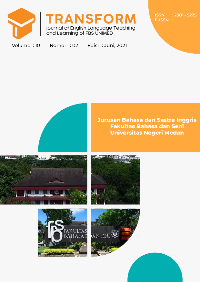Conversation Analysis of Turn-Taking Technique inœEllen Show Talkshow
DOI:
https://doi.org/10.24114/tj.v10i2.43287Keywords:
Turn-taking, Ellen Show, GenderAbstract
The research discussed about conversation analysis of turn-taking technique in œEllen Show talk show. Everyone should be familiar with œEllen Show this is one of the best popular talk show in American. The aims of this study were: (1) to find out the types of turn-taking techniques that used by the host of œEllen Show talk show by using Sacks (1974) in Garcia and Jacobs (2010) (2) to find out how the differences of turn-taking between male and female guests in œEllen Show talk show by using Pennebaker, J. W. (2007). The descriptive qualitative method is being used in this research. The data were derived from the dialogue script, which was transcribed from the video. The findings of the study revealed that: (1) there were three types of turn-taking current speaker select next, next speaker self-selection, current speaker continue. The highest frequency was current speaker select next. The host and guests in œEllen Show talk show used current speaker select next which appeared 21 times, next speaker self-selection was the second highest frequency which occurred 19 times, then the lowest frequency was current speaker continue produced by the host and guests which appeared 4 times in eight episodes. (2) In all eight episodes, women take more turns in talking seven times than males three times. The researcher recommends that future studies examine turn-taking from a variety of perspectives, such as how turn-taking is used in movies by gender or other factors. The researcher hopes that this study will be valuable to readers and future conversation analysis researchers.Downloads
Published
2023-02-03
Issue
Section
Articles
License
Copyright (c) 2023 Resha Febriza Matondang, Elisa Betty Manullang

This work is licensed under a Creative Commons Attribution-ShareAlike 4.0 International License.
Authors who publish with this journal agree with the following terms:
- Authors retain copyright and grant the journal right of first publication with the work simultaneously licensed under a Creative Commons Attribution License that allows others to share the work with an acknowledgment of the work's authorship and initial publication in this journal.
- Authors are able to enter into separate, additional contractual arrangements for the non-exclusive distribution of the journal's published version of the work (e.g., post it to an institutional repository or publish it in a book), with an acknowledgment of its initial publication in this journal.
- Authors are permitted and encouraged to post their work online (e.g., in institutional repositories or on their website) prior to and during the submission process, as it can lead to productive exchanges, as well as earlier and greater citation of published work (See The Effect of Open Access).
- This work is licensed under a Creative Commons Attribution-ShareAlike 4.0 International License.

This work is licensed under a Creative Commons Attribution-NonCommercial-ShareAlike 4.0 International License.



